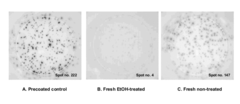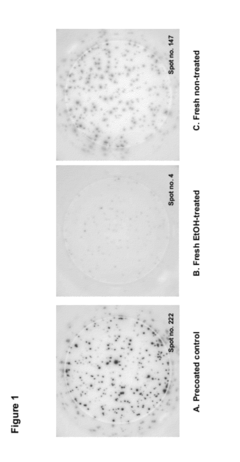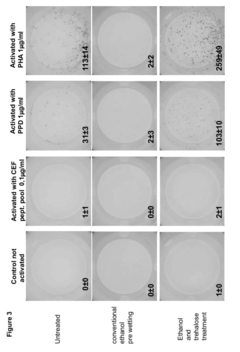How to Activate PVDF Membrane
PVDF Membrane Activation Background and Objectives
Polyvinylidene fluoride (PVDF) membranes have emerged as a crucial component in various industrial and scientific applications, particularly in filtration, separation, and purification processes. The activation of PVDF membranes is a critical step in enhancing their performance and expanding their utility across diverse fields. This technical research report aims to provide a comprehensive overview of PVDF membrane activation, its historical development, and the current objectives driving research in this area.
PVDF, a fluoropolymer discovered in the 1940s, gained prominence in membrane technology due to its excellent chemical resistance, thermal stability, and mechanical strength. The evolution of PVDF membrane activation techniques has been closely tied to the growing demands for improved membrane performance in water treatment, biomedical applications, and energy storage systems. Initially, PVDF membranes were used in their native hydrophobic state, limiting their applications in aqueous environments.
The need for hydrophilic PVDF membranes led to the development of various activation methods in the 1980s and 1990s. These early techniques primarily focused on surface modification through physical and chemical treatments. As research progressed, more sophisticated approaches emerged, including plasma treatment, UV-initiated grafting, and nanoparticle incorporation, each aiming to tailor the membrane's properties for specific applications.
The primary objective of PVDF membrane activation is to enhance the membrane's hydrophilicity, thereby improving its wettability and reducing fouling propensity. This modification is crucial for applications in water treatment and bioprocessing, where protein adsorption and bacterial adhesion can significantly impair membrane performance. Additionally, activation techniques aim to increase the membrane's porosity and pore size distribution, factors that directly influence filtration efficiency and selectivity.
Another key goal of PVDF membrane activation research is to develop methods that maintain the membrane's inherent mechanical and chemical stability while introducing new functional properties. This balance is essential for ensuring long-term performance and durability in harsh operating conditions. Researchers are also exploring ways to impart antimicrobial properties to PVDF membranes, addressing the persistent challenge of biofouling in membrane-based separation processes.
The current landscape of PVDF membrane activation research is driven by the need for sustainable and environmentally friendly modification techniques. There is a growing emphasis on developing activation methods that minimize the use of harmful chemicals and reduce energy consumption. This shift aligns with broader industry trends towards green chemistry and sustainable manufacturing practices.
As we look to the future, the objectives of PVDF membrane activation research are expanding to meet emerging challenges in advanced materials science and environmental technology. There is a push towards creating "smart" PVDF membranes with stimuli-responsive properties, capable of adapting to changing operational conditions. Furthermore, the integration of PVDF membranes with other advanced materials, such as graphene and metal-organic frameworks, is opening new avenues for membrane functionalization and performance enhancement.
Market Analysis for Activated PVDF Membranes
The market for activated PVDF membranes has been experiencing significant growth in recent years, driven by increasing demand across various industries. The global PVDF membrane market size was valued at approximately $937 million in 2020 and is projected to reach $1.5 billion by 2027, growing at a CAGR of 7.2% during the forecast period.
The water and wastewater treatment sector remains the largest application segment for activated PVDF membranes, accounting for over 40% of the market share. This is primarily due to the membrane's excellent chemical resistance, high mechanical strength, and superior filtration properties. The increasing focus on water reuse and recycling in industrial processes has further boosted the demand for PVDF membranes in this sector.
The biopharmaceutical industry is emerging as a rapidly growing market for activated PVDF membranes. The use of these membranes in protein purification, virus filtration, and sterile filtration processes has led to a surge in demand. The market in this segment is expected to grow at a CAGR of over 9% in the coming years.
Geographically, Asia Pacific dominates the activated PVDF membrane market, accounting for approximately 35% of the global market share. The region's rapid industrialization, growing population, and increasing water scarcity issues are driving the demand for advanced water treatment solutions. North America and Europe follow closely, with significant market shares due to stringent environmental regulations and the presence of major pharmaceutical and biotechnology companies.
The market is characterized by intense competition among key players such as Arkema, Merck Millipore, Koch Membrane Systems, and Pall Corporation. These companies are focusing on product innovations, strategic partnerships, and mergers and acquisitions to strengthen their market position. For instance, Arkema recently launched a new grade of PVDF specifically designed for membrane applications, offering improved performance and durability.
The COVID-19 pandemic has had a mixed impact on the activated PVDF membrane market. While it initially disrupted supply chains and manufacturing processes, the increased focus on healthcare and water treatment has led to a surge in demand for these membranes in critical applications such as vaccine production and medical device manufacturing.
Looking ahead, the market for activated PVDF membranes is expected to continue its growth trajectory. Factors such as increasing environmental concerns, stringent regulations on water quality, and the growing adoption of membrane technology in various industries will drive market expansion. However, challenges such as high initial costs and competition from alternative membrane materials may hinder growth to some extent.
Current Challenges in PVDF Membrane Activation
Despite the widespread use of PVDF membranes in various applications, their activation remains a significant challenge in the field. One of the primary obstacles is the inherent hydrophobicity of PVDF, which limits its wettability and hinders effective filtration processes. This hydrophobic nature often leads to membrane fouling and reduced performance, necessitating complex activation procedures.
The current activation methods for PVDF membranes often involve harsh chemical treatments or physical modifications, which can potentially compromise the membrane's structural integrity and long-term stability. Chemical treatments, such as alkaline hydrolysis or plasma treatment, while effective in increasing hydrophilicity, may alter the membrane's surface properties and pore structure, affecting its selectivity and permeability.
Another challenge lies in achieving uniform and consistent activation across the entire membrane surface. Uneven activation can result in heterogeneous surface properties, leading to inconsistent performance and reduced overall efficiency of the membrane system. This issue is particularly pronounced in large-scale industrial applications where maintaining uniformity across extensive membrane areas is crucial.
The durability of the activated state poses another significant hurdle. Many current activation techniques provide only temporary improvements in hydrophilicity, with the membrane gradually reverting to its hydrophobic state over time or under certain operating conditions. This necessitates frequent reactivation or replacement, increasing operational costs and downtime in industrial settings.
Furthermore, the environmental impact of some activation methods is a growing concern. The use of harsh chemicals or energy-intensive processes for activation contradicts the sustainability goals of many industries employing membrane technology. There is an increasing demand for eco-friendly activation methods that maintain membrane performance without compromising environmental standards.
Scalability of activation processes presents another challenge, especially when transitioning from laboratory-scale successes to industrial-scale applications. Methods that work well in small-scale experiments may face significant hurdles in large-scale implementation, including issues related to cost-effectiveness, process control, and quality assurance.
Lastly, the activation of PVDF membranes for specific applications, such as in biomedical or high-purity chemical processing, requires tailored approaches that do not introduce contaminants or alter the membrane's biocompatibility. Developing activation methods that are both effective and compatible with these sensitive applications remains a complex challenge in the field.
Existing PVDF Membrane Activation Methods
01 Chemical treatment for PVDF membrane activation
Chemical treatments are used to activate PVDF membranes, enhancing their surface properties and functionality. This process may involve the use of various chemicals or solutions to modify the membrane surface, improving its hydrophilicity, reactivity, or other desired characteristics.- Chemical treatment for PVDF membrane activation: Chemical treatments are used to activate PVDF membranes, enhancing their surface properties and functionality. This process may involve the use of various chemicals or solutions to modify the membrane surface, improving its hydrophilicity, reactivity, or other desired characteristics.
- Plasma treatment for PVDF membrane activation: Plasma treatment is employed to activate PVDF membranes, altering their surface properties without affecting the bulk material. This method can enhance membrane wettability, adhesion, and overall performance by introducing functional groups or modifying the surface structure.
- UV irradiation for PVDF membrane activation: Ultraviolet (UV) irradiation is utilized to activate PVDF membranes, inducing photochemical reactions on the membrane surface. This technique can improve membrane hydrophilicity, introduce functional groups, and enhance overall membrane performance for various applications.
- Thermal treatment for PVDF membrane activation: Thermal treatment methods are applied to activate PVDF membranes, involving controlled heating processes to modify membrane properties. This approach can alter the crystalline structure, improve mechanical strength, and enhance the membrane's overall performance characteristics.
- Surface grafting for PVDF membrane activation: Surface grafting techniques are employed to activate PVDF membranes by attaching functional molecules or polymers to the membrane surface. This method can tailor membrane properties such as hydrophilicity, fouling resistance, and selectivity for specific applications.
02 Plasma treatment for PVDF membrane activation
Plasma treatment is an effective method for activating PVDF membranes. This technique uses ionized gas to modify the membrane surface, introducing functional groups and improving properties such as wettability and adhesion. Plasma treatment can be tailored to achieve specific surface modifications.Expand Specific Solutions03 UV irradiation for PVDF membrane activation
Ultraviolet (UV) irradiation is employed to activate PVDF membranes. This method involves exposing the membrane to UV light, which can induce photochemical reactions on the surface, leading to the formation of reactive sites or functional groups. UV activation can enhance the membrane's performance in various applications.Expand Specific Solutions04 Thermal treatment for PVDF membrane activation
Thermal treatment is used to activate PVDF membranes by subjecting them to controlled heat. This process can alter the membrane's crystalline structure, surface properties, or induce chemical reactions, resulting in improved membrane characteristics such as porosity, mechanical strength, or chemical resistance.Expand Specific Solutions05 Combination of activation methods for PVDF membranes
Multiple activation methods are combined to achieve synergistic effects in PVDF membrane activation. This approach may involve sequential or simultaneous application of different techniques such as chemical treatment, plasma treatment, UV irradiation, or thermal treatment. The combination can result in enhanced membrane properties tailored for specific applications.Expand Specific Solutions
Key Players in PVDF Membrane Industry
The activation of PVDF membranes is a critical process in various industries, with the market currently in a growth phase. The global PVDF membrane market is expanding rapidly, driven by increasing applications in water treatment, pharmaceuticals, and energy storage. Technologically, the field is moderately mature, with ongoing innovations focused on improving membrane performance and durability. Companies like Arkema France SA, Pall Corp., and Toray Chemical Korea, Inc. are at the forefront of PVDF membrane technology, investing heavily in R&D to enhance activation methods. Emerging players such as Zhejiang University and Nanjing Tech University are contributing to advancements in activation techniques, while established firms like Cabot Corp. and Samsung SDI Co., Ltd. are exploring novel applications in energy and electronics sectors.
Arkema France SA
Pall Corp.
Innovative Approaches to PVDF Activation
- A molecularly imprinted composite membrane is prepared using cage-shaped fillers, specifically by modifying polyvinylidene fluoride membranes with polydopamine and amino cage polysilsesquioxane, followed by a pre-polymerization reaction and crosslinking to create a stable imprinted membrane that selectively recognizes phenylethanoid glycosides.
- A method involving the contact of PVDF membranes with an alcohol and a wetting agent, followed by drying, to permanently activate the membranes, eliminating the need for preactivation and reducing the risk of overtreatment, allowing for direct coating with proteins and use in assays without prior activation.
Environmental Impact of PVDF Activation Processes
The activation of PVDF membranes, while essential for various applications, carries significant environmental implications that warrant careful consideration. The processes involved in PVDF activation often require the use of chemicals and energy-intensive procedures, which can lead to environmental concerns if not properly managed.
One of the primary environmental impacts of PVDF activation processes is the generation of chemical waste. Many activation methods involve the use of strong acids, bases, or organic solvents, which can be harmful if released into the environment. These chemicals may contribute to water pollution if not adequately treated before disposal. Additionally, the production and transportation of these chemicals also have associated carbon footprints, further contributing to the overall environmental impact.
Energy consumption is another critical factor to consider. Activation processes often require elevated temperatures or the application of electrical fields, both of which demand substantial energy inputs. This energy consumption translates to increased greenhouse gas emissions, particularly if the energy source is not renewable. The carbon footprint of PVDF activation can be significant, especially in large-scale industrial applications.
Water usage is also a concern in many PVDF activation processes. Some methods require extensive washing steps to remove residual chemicals or to achieve the desired surface properties. This high water consumption can strain local water resources, particularly in water-scarce regions. Moreover, the wastewater generated from these processes may contain trace amounts of chemicals or PVDF particles, necessitating additional treatment before release.
The disposal of spent or deactivated PVDF membranes presents another environmental challenge. PVDF is a synthetic polymer that does not readily biodegrade, potentially contributing to long-term plastic pollution if not properly managed at the end of its lifecycle. Incineration of PVDF waste can release harmful compounds, including hydrogen fluoride, necessitating specialized disposal methods.
However, it's important to note that efforts are being made to mitigate these environmental impacts. Research is ongoing to develop more environmentally friendly activation processes, such as using supercritical CO2 or plasma treatments, which can reduce chemical waste and energy consumption. Additionally, advancements in membrane recycling technologies are showing promise in addressing end-of-life issues for PVDF membranes.
In conclusion, while PVDF activation processes present several environmental challenges, awareness of these issues is driving innovation towards more sustainable practices. Balancing the benefits of PVDF membranes with their environmental impact remains a key consideration for researchers and industry professionals alike.
Regulatory Compliance for PVDF Membrane Production
Regulatory compliance is a critical aspect of PVDF membrane production, ensuring the safety, quality, and consistency of the final product. The manufacturing process must adhere to various national and international standards, including Good Manufacturing Practices (GMP) and ISO certifications. Compliance with these regulations is essential for maintaining product integrity and meeting the stringent requirements of industries such as pharmaceuticals, biotechnology, and food processing.
One of the primary regulatory bodies overseeing PVDF membrane production is the Food and Drug Administration (FDA) in the United States. The FDA's guidelines for medical devices and pharmaceutical processing equipment are particularly relevant to PVDF membrane manufacturers. These guidelines cover aspects such as material selection, production processes, quality control, and documentation. Manufacturers must demonstrate that their PVDF membranes meet the FDA's requirements for biocompatibility, chemical resistance, and performance consistency.
In the European Union, the European Medicines Agency (EMA) provides regulatory oversight for PVDF membranes used in pharmaceutical applications. The EMA's guidelines focus on ensuring the safety and efficacy of medical products, including the materials used in their production. PVDF membrane manufacturers must comply with the EU's Medical Device Regulation (MDR) and In Vitro Diagnostic Regulation (IVDR) when their products are intended for medical applications.
Environmental regulations also play a significant role in PVDF membrane production. The manufacturing process must adhere to local and national environmental protection laws, addressing issues such as waste management, emissions control, and the use of hazardous materials. Many countries have implemented strict regulations on the use of certain chemicals and solvents, which may impact the production and activation processes of PVDF membranes.
Quality management systems are integral to regulatory compliance in PVDF membrane production. Manufacturers are expected to implement and maintain robust quality control measures throughout the production process. This includes regular testing and validation of membrane properties, such as pore size, porosity, and chemical resistance. Documentation of these quality control processes is essential for regulatory audits and inspections.
Traceability is another crucial aspect of regulatory compliance. Manufacturers must maintain detailed records of raw materials, production batches, and quality control tests. This information is vital for identifying and addressing any potential issues that may arise during production or after the product has been released to the market. Implementing a comprehensive traceability system also facilitates product recalls if necessary, demonstrating the manufacturer's commitment to product safety and quality.



